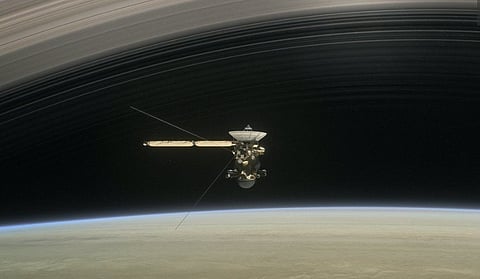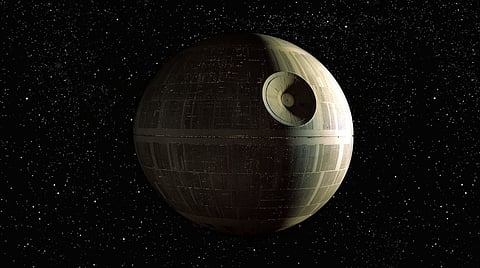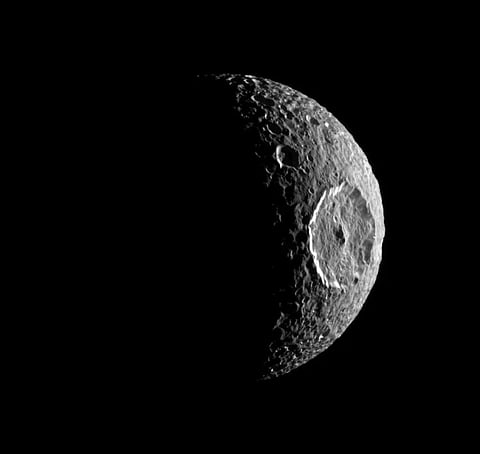Saturn's moon 'Mimas', famous for its striking resemblance to the ominous 'Death Star' from the original "Star Wars" film, also boasts another captivating feature, researchers reveal: a concealed subsurface ocean beneath its icy, crater-covered surface.
Saturn's 'Death Star' Moon Is Hiding A Young Vast Ocean Under Its Icy Crust, Scientists Say
Scientists have revealed that Saturn's moon Mimas, known for its resemblance to the 'Death Star,' harbors a hidden ocean beneath its icy surface, sparking intrigue about its potential for hosting life and offering insights into planetary evolution.
On Wednesday, astronomers announced that data gathered by NASA's Cassini spacecraft regarding the rotational dynamics and orbit of Mimas validate the existence of a liquid water ocean hidden beneath an ice layer measuring 12-19 miles (20-30 km) thick. This ocean, they noted, seems to have emerged relatively recently in astronomical time scale, dating back less than 25 million years and likely originating between 5 and 15 million years ago.
These discoveries render Mimas an intriguing destination for exploration, offering insights into the environmental conditions conducive to the emergence of life. This is particularly significant given that Earth's earliest life forms emerged in our planet's ancient oceans billions of years ago.
"At first glance, it is the most unlikely place in the solar system to look for liquid water," said Valery Lainey, an astronomer from the Observatoire de Paris and the lead author of the study published in the journal Nature. "It looks old and inactive - a huge amount of craters. Nothing betrays the ocean existence, at the moment."
Lainey noted that Mimas joins the ranks of the five moons in our solar system with convincing evidence of subsurface oceans, making it the smallest among them. These moons include Saturn's Enceladus and Titan, as well as Jupiter's Europa and Ganymede. Additionally, there are suspicions of subsurface oceans on a few other moons, including Jupiter's Callisto.

In 2017, after 13 years of scrutinizing Saturn and its moons, the Cassini mission concluded with a deliberate descent into the atmosphere of the expansive ringed planet. Despite Cassini's extensive observations of Mimas' icy terrain, no surface deformations indicative of an underlying ocean were detected. However, researchers deduced that certain characteristics of its orbit could only be elucidated by the existence of an internal ocean rather than a solid core.
Mimas ranks as the seventh-largest moon orbiting Saturn. In total, Saturn boasts a multitude of moons, numbering well over 100, with sizes varying from Titan, larger than the planet Mercury, to some as small as a city block.
Mimas, characterized by its slightly irregular shape, boasts an average diameter of approximately 250 miles (400 km). Like our moon's relationship with Earth, Mimas is tidally locked with Saturn, always presenting the same side towards the planet. Its most notable feature is the Herschel crater, spanning a third of its surface and giving it a resemblance to the Death Star.

Earth's moon outweighs Mimas by approximately 2,000 times in mass.
The existence of an internal ocean suggests the presence of a potent heat source within Mimas, responsible for transforming ice into liquid water. Mimas follows an elliptical trajectory around Saturn, maintaining an average distance of around 115,000 miles (186,000 km). Throughout its orbit, the varying distance from Saturn leads to fluctuations in the gravitational and tidal forces exerted by the planet.
Planetary scientist and co-author of the study, Gabriel Tobie from the French scientific research agency CNRS and Nantes Université, explained, "This results in periodic deformation of Mimas' interior, and part of the energy involved in these deformations is converted into heat."
The liquid water contained within Mimas constitutes over half of the moon's total volume, even though it only accounts for approximately 1.2-1.4% of the volume of Earth's oceans. Researchers further noted that the proximity of this water to Mimas' rocky core could promote the intricate chemical processes that could pave the way for life.

Researchers speculate that the fundamental components necessary for life, including warmth, water, and organic compounds, are present within the Saturnian system, particularly on Enceladus, which exhibits massive plumes erupting from its surface. However, Gabriel Tobie pointed out that even if Mimas possesses these essential ingredients, the youthfulness of its ocean "might be a challenge for life's development."
"However, nobody knows how long life needs to emerge from a suitable environment," Tobie added. "Mimas may offer a unique opportunity to explore the first stage of life's development."